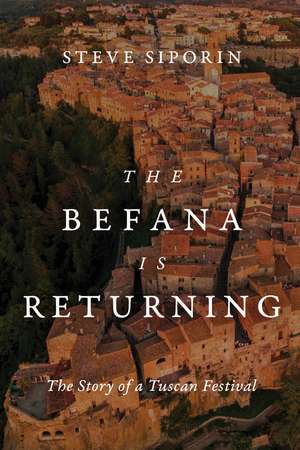The Befana Is Returning: The Story of a Tuscan Festival
Autor Steve Siporinen Limba Engleză Hardback – 16 aug 2022
The Pigitliano Befanata is distinct in its emphasis on song and strong in its richly symbolic use of food, which is not only consumed at each home but is also carried away as a gift. The characters who make up the squad are unique to the Italian practice. They always include the Befana and her husband, the Befano, but other members of the befanotti vary from place to place over time. Siporin combines fieldwork and archival evidence to introduce the Befanata and its historical and social contexts: what it is, what it means, and how it feels. The Befana Is Returning is a deeply researched, deftly insightful presentation of this living tradition that adds a large missing piece to the array of contemporary ethnographic scholarship on mumming.
Preț: 415.73 lei
Preț vechi: 467.10 lei
-11% Nou
Puncte Express: 624
Preț estimativ în valută:
79.56€ • 86.39$ • 66.83£
79.56€ • 86.39$ • 66.83£
Carte disponibilă
Livrare economică 01-15 aprilie
Preluare comenzi: 021 569.72.76
Specificații
ISBN-13: 9780299337308
ISBN-10: 0299337308
Pagini: 312
Ilustrații: 26 b-w illus.
Dimensiuni: 152 x 229 x 36 mm
Greutate: 0.63 kg
Ediția:First Edition
Editura: University of Wisconsin Press
Colecția University of Wisconsin Press
ISBN-10: 0299337308
Pagini: 312
Ilustrații: 26 b-w illus.
Dimensiuni: 152 x 229 x 36 mm
Greutate: 0.63 kg
Ediția:First Edition
Editura: University of Wisconsin Press
Colecția University of Wisconsin Press
Notă biografică
Steve Siporin is professor emeritus in English and history (folklore) at Utah State University, where he also served as the director of the folklore program and coordinator for public folklore studies. He is the author, coeditor, and translator of several books, most recently Stories of Jewish Life: Casale Monferato-Rome-Jerusalem, 1876–1985 by Augusto Sergre.
Cuprins
List of Illustrations
Preface
Acknowledgments
Introduction
1 History
2 Season and Cycle
3 Mezzadria
4 Food
5 Song
6 The Old Woman
7 The Befana Is Returning
8 The Exchange
Epilogue
Appendix: The Magical Night
Notes
Bibliography
Index
Preface
Acknowledgments
Introduction
1 History
2 Season and Cycle
3 Mezzadria
4 Food
5 Song
6 The Old Woman
7 The Befana Is Returning
8 The Exchange
Epilogue
Appendix: The Magical Night
Notes
Bibliography
Index
Recenzii
Winner of the Wayland D. Hand Prize, American Folklore Society
“A seminal work of meticulously detailed scholarship. . . . The Befana Is Returning: The Story of a Tuscan Festival will have a special and particular appeal to readers with an interest in Italian folklore, history and mythology.”
“[An] excellent study of the history and contemporary practice of the Befanata custom in Italy and beyond. . . . A classical folklore investigation in the best sense of the term. . . . Sensitive and comprehensive.”
“Siporin’s engaging work does a masterful job of inviting us to think deeply about the functions and meanings of expressive cultural forms, as well as the ongoing tensions of tradition and change.”
“Offers a rich exploration of the historical, cultural, geographic, and social contexts that shape traditional practices and allow them to thrive. It is a beautiful, affecting book that embeds within ‘the story of a Tuscan festival’ a model for the craft of folklore I all its rewarding complexity.”
“Siporin’s delightful, thoroughly researched book transports us to the Tuscan countryside to reveal the mysterious Befana’s story. From her roots as a pre-Roman goddess, to her pop cultural presence today, the Befana is at heart about the light of community, connection, and conviviality in the darkness of a winter’s night.”
“Siporin’s insightful analysis of this centuries-old mumming tradition helps us understand human connection to the yearly cycle, family and community structures, the ravages of Early Modern period hunger and poverty, and the fragility of folk tradition in the twenty-first century.”
Descriere
On the night of January 5, in certain areas of southern Tuscany, a costumed, singing troupe of characters visits residents’ homes, expecting to be fed and feted. This is the Befanata, a mumming tradition centered in Tuscany, whose main character—the Befana—is a kindly old woman or grandmotherly witch who delivers toys, candies, and gifts. The Befana Is Returning is a deeply researched, deftly insightful presentation of this living tradition that adds a large missing piece to the array of contemporary ethnographic scholarship on mumming.
